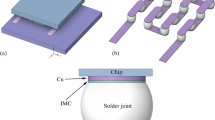Abstract
The demand for miniaturised electronic devices has led to various challenges in microelectronic industries. One of the challenge is the removal of fans in some applications, which has led to increased heat retention, thereby causing overheating. In the assembly of electronic devices, thermal interface materials (TIMs) can be used for bonding the surface between the flip chip and a heat sink base or heat spreader. Lead-free solder (Sn-Ag-Cu) alloys are becoming more popular as TIMs in electronic assembly. Therefore, these lead-free solders could fail during operation at elevated temperatures over a period of time. The reliability of lead-free TIMs is vital in sustaining the life span of an electronic device. Three Sn-Ag-Cu (SAC) solders were considered for this investigation, namely, SAC305, SAC105, and SAC396. An ANSYS design modeller was used in the design and analysis of the microelectronic application investigated. Temperature loads ranging between 100°C and 200°C were applied over a period of time during the simulation of the electronic package. The findings from the research suggested that the SAC305 solder TIMs will outperform SAC105 and SAC396 during operation. This is because SAC305 can accommodate more stress, while the strain rate is low compared to SAC105 and SAC396. In addition, the fatigue life of SAC305 was higher than that of SAC105 and SAC396 in the different temperature ranges investigated. Therefore, SAC305 is recommended as a better thermal interface material compared to SAC105 and SAC396.







Similar content being viewed by others
References
A.A. Almubarak, Int. J. Eng. Res. Appl. 7, 52 (2017).
K. Vijay. Solder-TIMs (thermal interface materials) for superior thermal management in power electronics, in 4th Electronic System-Integration Technology Conference (2012), p. 1
M. Ekpu, R. Bhatti, M.I. Okereke, and K. Otiaba, Fatigue life analysis of Sn96.5Ag3.0Cu0.5 solder thermal interface material of a chip-heat sink assembly in microelectronic applications, in 46th International Symposium on Microelectronics, IMAPS (2013), p. 473
G.L. Chiu and S. Kang, Multipath Soldered Thermal Interface Between a Chip and its Heat Sink, United States Patent, Patent No US 8679899 B2 (2014)
M. Jiang, G. Fu, B. Wan, P. Xue, Y. Qiu, and Y. Li, Solder. Surf. Mt. Technol. 30, 49 (2018).
P. Lall, D. Zhang, V. Yadav, J. Suhling, and D. Locker, Effect of temperature on the high strain rate properties of SAC lead-free alloys at temperatures up to 200°C, in IEEE 66th Electronic Components and Technology Conference (2016), p. 1924
C. Buttay, D. Planson, B. Allard, D. Bergogne, P. Bevilacqua, C. Joubert, M. Lazar, C. Martin, H. Morel, D. Tournier, and C. Raynaud, Mater. Sci. Eng. B 176, 283 (2011).
L. Zhang, J. Han, C. He, and Y. Guo, J. Mater. Sci.: Mater. Electron. 24, 172 (2013).
G. Henshall, J. Bath, S. Sethuraman, D. Geiger, A. Syed, M.J. Lee, K. Newman, L. Hu, D.H. Kim, W. **e, W. Eagar, and J. Waldvogel, Comparison of thermal fatigue performance of SAC105 (Sn-1.0Ag-0.5Cu), Sn-3.5Ag, and SAC305 (Sn-3.0Ag-0.5Cu) BGA components with SAC305 solder paste, in Proceedings of APEX (2009), p. 1
J.H.L. Pang, B.S. **ong, and T.H. Low, Creep and fatigue characterization of lead free 95.5Sn-3.8Ag-0.7Cu solder, in Electronic Components and Technology Conference (2004), p. 1333
J.H. Lau, J. Electron. Packag. 128, 297 (2006).
F.K.A. Nyarko, and G. Takyi, Solder. Surf. Mt. Technol. (2021). https://doi.org/10.1108/SSMT-10-2020-0045.
S. Tikale, and K.N. Prabhu, Mater. Sci. Eng. A. (2020). https://doi.org/10.1016/j.msea.2020.139439.
R.A. Athamneh, D.B. Hani, H. Ali, and S. Hamasha, Microelectron. Reliab. (2020). https://doi.org/10.1016/j.microrel.2019.113507.
M. Ochiai, T. Akamatsu, and H. Ueda, FUJITSU Sci. Tech. J. 38, 96 (2002).
E. Suhir, J. Therm. Stress 36, 537 (2013).
M.I. Okereke, and Y. Ling, Appl. Therm. Eng. 142, 346 (2018).
M. Ekpu, Solder. Surf. Mt. Technol. (2021). https://doi.org/10.1108/SSMT-07-2020-0033.
J.A. Depiver, S. Mallik, and E.H. Amalu, J. Electron. Mater. 50, 263 (2021).
M. Ekpu, R. Bhatti, M.I. Okereke, S. Mallik, and K. Otiaba, Microelectron. Reliab. 54, 239 (2014).
J.A. Depiver, S. Mallik, and E.H. Amalu, Creep response of various solders used in soldering ball grid array (BGA) on printed circuit board (PCB), in Proceedings of the World Congress on Engineering and Computer Science (2019), p. 1
X. Yan and G. Li, Study of thermal fatigue lifetime of fan-in package on package (FiPoP) by finite element analysis, in ICEPT-HDP Conference Proceedings (2009), p. 1176
G.Z. Wang, Z.N. Cheng, K. Becker, and J. Wilde, ASME J. Electron. Packag. 123, 247 (2001).
L. Zhang, Z. Liu, and Y. Ji, Anand constitutive model of lead-free solder joints in 3D IC device, in 5th International Conference on Mathematical Modeling in Physical Sciences, IOP Publishing, J. Phys.: Conference Series (2016), p. 738
M. Motalab, Z. Cai, J.C. Suhling, and P. Lall, Determination of Anand constants for SAC solders using stress-strain or creep data, in 13th IEEE ITHERM Conference (2012), p. 910
X. Chen, G. Chen, and M. Sakane, IEEE Trans. Compon. Packag. Technol. 28, 111 (2005).
A. Syed, in Accumulated Creep Strain and Energy Density Based Thermal Fatigue Life Prediction Models for SnAgCu Solder Joints. Electron. Compon. Technol. Conference (2004), p. 737
M.S. Alam, J.C. Suhling, and P. Lall, High temperature tensile and creep behavior of lead free solders, in 16th IEEE ITHERM Conference (2017), p. 1229
M. Aamir, M. Waqas, M. Iqbal, M.I. Hanif, and R. Muhammad, Solder. Surf. Mt. Technol. (2017). https://doi.org/10.1108/SSMT-02-2017-0005.
JEDEC, in Temperature Cycling in JESD22-A104D (JEDEC Solid State Technology Association, 2009), p. 1
M. Ekpu, J. Appl. Sci. Environ. Manag. 23, 2059 (2019).
Author information
Authors and Affiliations
Corresponding author
Ethics declarations
Conflict of interest
The author declare that there is no conflict of interest.
Additional information
Publisher's Note
Springer Nature remains neutral with regard to jurisdictional claims in published maps and institutional affiliations.
Rights and permissions
About this article
Cite this article
Ekpu, M. Investigating the Reliability of SnAgCu Solder Alloys at Elevated Temperatures in Microelectronic Applications. Journal of Elec Materi 50, 4433–4441 (2021). https://doi.org/10.1007/s11664-021-08968-8
Received:
Accepted:
Published:
Issue Date:
DOI: https://doi.org/10.1007/s11664-021-08968-8



